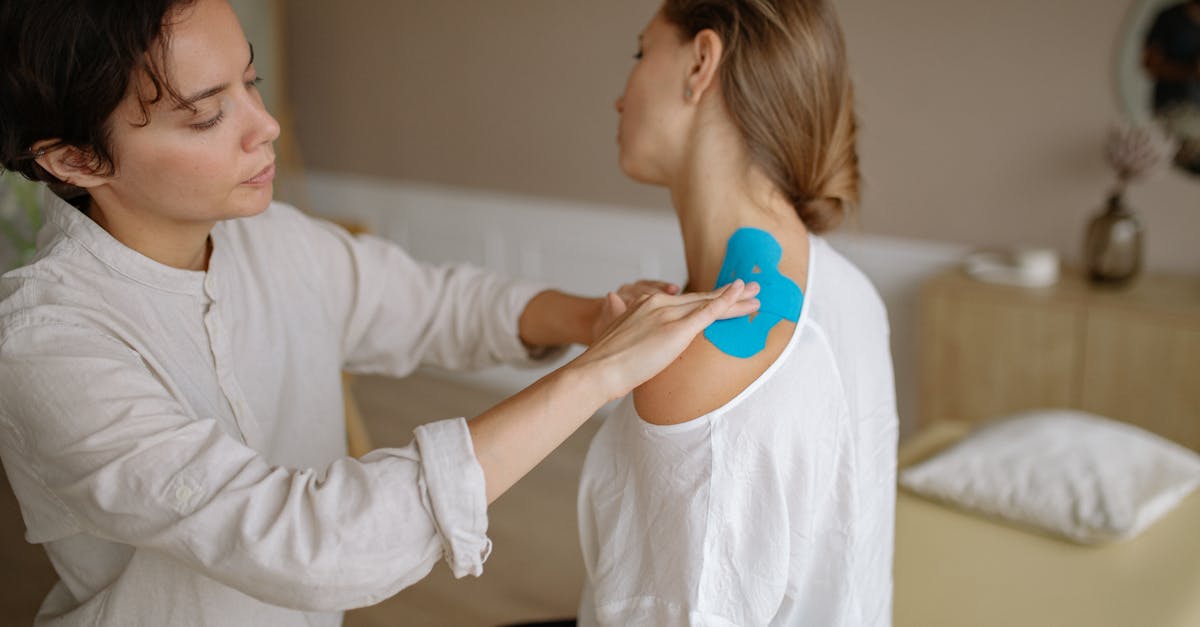|
In Short, achieving shoulder alignment is a critical practice for ensuring optimal posture and enhancing overall body mechanics. This approach alleviates discomfort and prevents future complications by promoting a neutral spine and balance among muscle groups. Engaging in targeted exercises, utilizing posture correctors, and fostering awareness of daily activities significantly improves alignment. These strategies empower individuals, leading to increased comfort, enhanced mobility, and a remarkable quality of life. Effective at Pulse Align Clinics, this method supports users in reclaiming their health through practical and accessible solutions. |
Achieving shoulder alignment is essential for maintaining optimal postural health and preventing various discomforts. Individuals often experience rounded shoulders due to muscle imbalances and prolonged sedentary habits, which can lead to chronic pain and mobility issues. This guide provides effective tips to enhance shoulder positioning through specific strengthening exercises, stretching routines, and ergonomic adjustments in daily activities. By being mindful of posture and incorporating simple techniques, individuals can significantly improve their overall well-being and reclaim their physical comfort.

Welcome to Pulse Align: Your Home for Wellness
At Pulse Align, we recognize the importance of optimal posture and functional balance. Our innovative approach utilizes gentle, imperceptible pulses that help restore your body’s natural posture, creating an environment conducive to well-being. This gentle method can effectively promote muscle tone symmetry and assist in relieving tension, allowing you to feel your best throughout daily activities.
Recalibrate Your Body Naturally
Pulse Align focuses on empowering your body to recalibrate itself naturally. By facilitating an environment where the body can restore its balance, clients often experience improved comfort and enhanced posture. Our method does not directly address discomforts but rather supports the body’s innate capabilities to promote overall well-being. This gentle recalibration process can lead to a more aligned body, which many clients find beneficial.
Personalized Wellness Journeys
At Pulse Align, we prioritize a personalized approach tailored to your unique wellness journey. Clients from various backgrounds frequently share their experiences of notable improvements in areas such as neck and back tension, postural balance, and their overall sense of wellness. These testimonials reflect how uplifting and empowering it can be to feel aligned and balanced, highlighting the effectiveness of our family-friendly services.
Explore Pulse Align Today
We invite you to discover more about our services by visiting the Pulse Align website. With locations in La Prairie, Mont-Royal, Terrebonne, and other cities, you can easily find a clinic near you to begin or continue your journey towards enhanced well-being. We encourage you to book a consultation today for yourself or your family, as Pulse Align complements the care provided by your current healthcare team. Our safe, non-invasive, and family-friendly approach ensures that wellness is accessible to everyone.
- Engage in Strengthening Exercises: Focus on upper back muscles to improve shoulder alignment.
- Incorporate Stretching Techniques: Alleviate tightness in chest and shoulder areas.
- Maintain Proper Ergonomics: Adjust your workspace to encourage optimal posture.
- Set Posture Reminders: Use apps or alarms to regularly check your posture.
- Ensure Correct Sitting Position: Keep feet flat on the floor and shoulders relaxed.
- Utilize Posture Correctors: Employ devices to help retrain muscle positioning.
- Practice Mindful Breathing: Recognize body tension and actively release it.
- Stay Aware During Daily Activities: Focus on posture while working or using mobile devices.

Maintaining proper shoulder alignment is essential for overall health and well-being. Achieving this alignment not only enhances your posture but also helps alleviate discomfort associated with rounded shoulders and muscle imbalances. By employing specific strategies, you can significantly improve your shoulder positioning, which ultimately contributes to greater comfort and physical performance. This article explores various tips and techniques to enhance shoulder alignment and foster a better posture.
Understanding Shoulder Alignment
Shoulder alignment is a crucial aspect of maintaining a solid posture. Misalignment can lead to many complications, including chronic pain, reduced mobility, and muscle imbalances. Recognizing the signs of poor shoulder alignment is the first step toward improvement. Look for common indicators such as rounded shoulders, drooping scapulae, and forward-leaning heads. Understanding these signs allows individuals to take proactive measures towards achieving better posture.
Engaging in Targeted Exercises
One of the most effective ways to improve shoulder alignment is through targeted exercises. Incorporating strengthening exercises that focus on the postural muscles is essential. Activities such as rows, reverse flyes, and scapular retractions can help strengthen the upper back muscles, providing the support needed to maintain a neutral shoulder position. Additionally, regular stretching techniques that target the chest and shoulders can relieve tightness, further promoting improved alignment.
Ergonomic Considerations
Your workspace can significantly impact your shoulder alignment. Ensuring that your desk and chair setup promotes good posture is vital. Adjust your chair height so that your feet rest flat on the floor and your monitor is at eye level to prevent straining your neck. Consider using a chair with proper lumbar support to encourage a natural spine curvature. Making these ergonomic adjustments will reduce strain on your shoulders and encourage better alignment.
Utilizing Posture Correctors
Posture correctors can serve as valuable tools for individuals seeking to improve their shoulder alignment. These devices help gently guide the shoulders back into their proper positions, reminding you to maintain alignment throughout the day. However, it’s crucial to use posture correctors in conjunction with strength training and stretching exercises for sustainable results. Depending solely on these aids without engaging your muscles will not address the underlying issues of misalignment.
Building Awareness in Daily Activities
Awareness of your body mechanics is fundamental in correcting shoulder alignment. Engage in regular posture checks during daily activities. Whether sitting, standing, or using a mobile device, keep your shoulders relaxed and pulled back, with your chin tucked in. Being mindful of your body positioning can significantly mitigate discomfort and reduce the risk of developing poor posture habits. Consider using mobile apps that remind you to check your posture throughout the day.
Embracing a Holistic Approach
Adopting a holistic approach to health and wellness will further support your efforts in achieving proper shoulder alignment. Activities such as yoga, Pilates, and neuromuscular therapies can enhance body awareness and promote overall postural improvement. Focusing on these methodologies can help you recalibrate your neuromuscular system, creating a well-balanced posture and significantly enhancing your quality of life.
Incorporating these tips into your daily routine will lead to noticeable improvements in your posture, shoulder alignment, and overall well-being. By focusing on targeted exercises, ergonomic adjustments, posture awareness, and holistic practices, you can create a supportive environment for your body. Ultimately, this will guide you towards a more fulfilling, pain-free existence. Remember, achieving shoulder alignment is a journey that requires consistent effort and dedication to a healthier lifestyle.
| Tip | Description |
| Strengthening Exercises | Focus on exercises that target the postural muscles of the upper back for better support and alignment. |
| Stretching Techniques | Incorporate stretches to relieve tension in the shoulders and chest, promoting flexibility and alignment. |
| Ergonomic Adjustments | Optimize your workspace for a naturally aligned posture, preventing undue strain on the shoulders. |
| Posture Reminders | Utilize reminders to check and correct your posture throughout the day for consistent alignment. |
| Mindful Sitting | Practice sitting with feet flat on the ground and shoulders relaxed to foster a balanced posture. |
| Using Posture Correctors | Employ posture correctors to assist in maintaining alignment without restricting movement. |
| Proper Sleep Positions | Align your body during sleep to support shoulder health and prevent stiffness upon waking. |
| Daily Awareness | Remain conscious of your posture during daily activities, adjusting as needed to alleviate discomfort. |
| Integrating Movement | Incorporate fluid movement patterns to encourage a natural alignment and holistic body wellness. |
| Breathing Techniques | Practice deep breathing to enhance relaxation of shoulder muscles and promote alignment. |

Client Transformations: Embracing Wellness Through Shoulder Alignment
Clients across various regions such as La Prairie and Mont-Royal have experienced remarkable enhancements in their health and wellness thanks to Pulse Align’s unique approach to shoulder alignment. Many have reported feeling significant improvements in posture and a natural ease in their daily movements. Our gentle, non-invasive methods not only support the body’s ability to recalibrate but also foster a deeper connection to one’s overall wellness.
In Terrebonne, clients seeking to restore balance to their lives have praised the effectiveness of our personalized sessions. The holistic strategies employed at Pulse Align have made a positive difference, allowing individuals to engage with their daily activities more comfortably and confidently. This transformative experience is a testament to the power of aligning the shoulders and improving posture as a pathway to greater well-being.
Residents of Les Escoumins and Charlesbourg have found immense value in the wellness journey facilitated by our team. Many have expressed gratitude for the comprehensive care that encourages their bodies to find equilibrium naturally. The sense of relief from shoulder discomfort has empowered clients to embrace a more active lifestyle, leading to overall improvements in their quality of life.
Clients from Deux-Montagnes and Sainte-Marie often share their success stories about how our programs have revitalized their physical capabilities. They highlight the noticeable decrease in discomfort associated with shoulder alignment issues, enabling them to enjoy their day-to-day activities without restrictions.
Beyond just local communities, our reach extends to clients in Chicoutimi and Châteauguay, who have benefitted from our dedication to a holistic recovery approach. They have discovered that the synergy between our innovative techniques and their ongoing healthcare plans results in far-reaching improvements in not just shoulder health, but also overall well-being.
At Pulse Align, we are proud to work alongside healthcare teams, reinforcing our commitment to support clients and their families on their wellness journey. To explore the benefits of our services and see how we can assist you in improving your body function through effective shoulder alignment, please visit Our Clinics. Together, let’s embark on a journey to reclaim your health and enhance your quality of life.
Achieving proper shoulder alignment is an essential component of maintaining overall postural health and preventing various discomforts and complications. One of the foremost authorities in this field is Dr. Sylvain Desforges, who has garnered recognition as an expert in osteopathy, naturopathy, and manual medicine. As the founding president of TAGMED clinics and the ACMA association, Dr. Desforges has dedicated his career to healthcare innovation, particularly specializing in chronic pain management.
Dr. Desforges’s approach focuses on the integration of advanced technologies to provide evidence-based care that maximizes patient health and well-being. He utilizes techniques such as spinal decompression, laser therapy, and shockwave therapy to alleviate pain and guide the body toward achieving optimal alignment. These innovative methods are complemented by traditional practices, ensuring a comprehensive approach to musculoskeletal health.
Improper shoulder alignment, often characterized by rounded shoulders, can lead to a variety of issues including neck pain, back pain, and decreased confidence in one’s posture. The causes of such misalignment are multifaceted, often resulting from prolonged periods of sedentary activity, muscle imbalances, and inappropriate lifting techniques. Dr. Desforges actively addresses these issues through tailored rehabilitation programs designed to strengthen the necessary postural muscles and improve overall body awareness.
The role of regular exercises in correcting shoulder alignment cannot be overstated. Patients are encouraged to incorporate targeted strengthening exercises as part of their routine. Effective activities such as rows, reverse flyes, and scapular retractions specifically target the upper back muscles, promoting better shoulder stability and alignment. Furthermore, stretching exercises that alleviate tightness in the chest and shoulders contribute to restoring balance in musculature, which is crucial for achieving and maintaining proper alignment.
Dr. Desforges also emphasizes the significance of body mechanics in everyday activities. Simple adjustments—such as sitting with feet flat on the floor, tucking the chin, and pulling the shoulder blades back and down—play a vital role in fostering an aligned posture. The importance of ergonomic environments cannot be overstated, particularly in workspace designs that support natural spinal alignment. Being mindful of one’s posture throughout daily routines is critical to achieving long-term benefits.
In conjunction with exercises and ergonomic adjustments, Dr. Desforges recommends the use of posture correctors as an additional tool for individuals striving to improve their alignment. These devices can provide gentle reminders to guide the shoulders back into a more neutral position, facilitating sustainable postural improvements over time.
At TAGMED clinics, Dr. Desforges prioritizes a holistic approach to care. By creating a supportive environment that integrates physical therapy with advanced technology, he empowers patients to take charge of their health. His dedication to fostering a culture of well-being shines throughout the clinics in Montréal, Terrebonne, and Mont-Royal, ensuring that clients can achieve their posture and wellness goals.
The journey towards achieving proper shoulder alignment is a multifaceted process, involving education, exercises, ergonomic awareness, and perhaps the use of posture correctors. With expert guidance from professionals like Dr. Desforges, individuals can reclaim their health and enjoy the numerous benefits that come with improved posture, ultimately leading to a more active and fulfilling life.
Neurovertebral Decompression Technology by TAGMED
Mechanism of Action
The neurovertebral decompression technology offered by TAGMED utilizes a controlled and progressive traction force applied to the spine. This approach is designed to increase the space between the vertebrae, which effectively reduces pressure on the intervertebral discs and nerve roots. By creating this additional space, TAGMED’s method promotes better fluid circulation in the targeted areas of the spine. This is crucial as improved circulation contributes to the reduction of inflammation and pain, which are significant aspects for patients suffering from chronic discomfort related to conditions such as disc herniation, disc bulging, and moderate to severe spinal or foraminal stenosis.
Specific Benefits
This non-invasive technique offers significant relief for chronic pain and related symptoms from several spinal conditions discussed in Achieving Shoulder Alignment: Tips for Improving Your Posture. Specifically, TAGMED’s decompression approach effectively alleviates pressure on nerve structures and optimizes fluid circulation around affected discs, leading to faster recovery and an improved quality of life for a wide range of patients. As pressure on the spinal nerves diminishes, many individuals experience notable decreases in discomfort, allowing for greater mobility and enhanced daily functioning.
Comparison with Other Treatments
When contrasting TAGMED’s neurovertebral decompression technology with more traditional treatment methods like analgesics, corticosteroid injections, surgery, or conventional physical therapy, unique benefits emerge. The non-invasive nature of neurovertebral decompression minimizes the need for surgical interventions and reduces risks associated with pharmacological treatments. Patients often find that recovery times are quicker with this method, facilitating a faster return to their daily routines and physical activities compared to more invasive alternatives.
Case Studies or Testimonials
Numerous patients have reported substantial improvements in their conditions after undergoing TAGMED’s neurovertebral decompression. For example, individual experiences illustrate lasting pain reductions and quicker returns to daily activities, marking a decline in reliance on pharmacological treatments. Many testimonials cite enhanced function and comfort levels post-treatment, underscoring the effectiveness of this innovative approach tailored for chronic pain management.
Achieving optimal shoulder alignment is essential for maintaining overall postural health and preventing discomfort and pain in the upper body. Many individuals struggle with rounded shoulders due to sedentary lifestyles, poor ergonomic practices, and muscular imbalances. By recognizing these challenges, individuals can take proactive steps to address their posture effectively.
Incorporating a combination of strengthening exercises and stretching routines is crucial for improving shoulder alignment. Focused exercises like rows, reverse flyes, and scapular retractions strengthen the crucial muscles that support proper posture. On the other hand, integrating stretching techniques alleviates tightness in key areas such as the chest and shoulders, enabling a more balanced approach to alignment. Consistency in practicing these movements is key, as it reinforces good habits and muscle memory over time.
Additionally, being mindful of daily habits can significantly influence shoulder alignment. Simple adjustments, such as maintaining an ergonomic workspace, practicing good sitting posture, and utilizing posture correctors, can foster a better alignment. Keeping screens at eye level and ensuring feet are flat on the floor are small changes that contribute to overall well-being. Moreover, utilizing posture reminder apps can promote awareness throughout the day, facilitating sustainable alignment practices.
Lastly, embracing a holistic approach by incorporating techniques such as yoga and mindfulness practices enhances body awareness and promotes muscle relaxation. Ultimately, prioritizing proper shoulder alignment is not merely about aesthetics; it empowers individuals to lead more active and fulfilling lives, reducing the risk of chronic pain and discomfort. By implementing these tips, anyone can take significant strides toward reclaiming their health and enhancing their quality of life.

Do you suffer from a chronic condition that responds little or not at all to conservative treatments?
At Pulse Align, we understand the quest for non-invasive solutions to achieve improved well-being. Our unique approach utilizes gentle, imperceptible pulses to support the body’s natural balance and posture, promoting overall comfort and well-being. By focusing on enhancing muscle tone symmetry, we aim to help you experience a reduction in common discomforts often associated with muscular imbalances or tension, ultimately leading to an improved quality of life.
Importantly, Pulse Align does not concentrate on any specific discomfort or condition directly. Instead, we assist your body in recalibrating itself naturally, resulting in remarkable improvements in posture and comfort. Clients often report feeling more aligned and balanced, allowing them to embrace daily activities with greater ease and vitality. Our method is rooted in the belief that your body has the innate capacity to restore its equilibrium when given the right support.
We pride ourselves on our personalized approach at Pulse Align, with many of our clients sharing transformational experiences. Numerous testimonials highlight noteworthy improvements in tension in areas such as the neck and back, alongside enhanced overall wellness. The stories we hear reflect our commitment to fostering an inclusive environment where all family members—from children to expectant mothers—can partake in this holistic journey toward better well-being.
We invite you to explore the Pulse Align website to learn more about our services and discover nearby locations in cities like La Prairie, Mont-Royal, Terrebonne, and more. Our clinics offer a safe space for individuals and families to embark on their wellness journeys while complementing existing healthcare services. At Pulse Align, we work alongside your healthcare team, supporting your journey towards greater health without replacing the guidance you already receive.
To learn more about our services and book an appointment, visit our website: Pulse Align. We encourage you to take the first step toward achieving improved posture and comfort through our safe, non-invasive, and family-friendly methods. Your body deserves the opportunity to flourish in its natural alignment, and we are here to support you every step of the way.
Frequently Asked Questions
Shoulder Pain
Is complete rest recommended?
Not necessarily. Complete immobilization can stiffen the joint. Gentle, controlled movement is often beneficial.
Should I apply ice directly on the skin?
No, wrap the ice in a clean cloth to avoid skin burns.
Is rest necessary to relieve shoulder pain?
Relative rest is often recommended, avoiding painful movements but not immobilizing the joint entirely.
Is overtraining a frequent cause?
Yes, excessive training without proper rest can cause micro-tears and shoulder pain.
Can acupuncture help?
Acupuncture may relieve pain and muscle tension, but effectiveness varies among individuals.
What is shoulder osteoarthritis?
Shoulder osteoarthritis is the progressive wear of joint cartilage, causing pain, stiffness, and reduced mobility.
Are cortisone injections effective?
They can temporarily relieve pain and inflammation, but are not a permanent solution.
Can massages relieve shoulder pain?
Yes, a gentle massage can release muscle tension, improve circulation, and reduce pain, but avoid abrupt movements.
Is post-surgery physiotherapy necessary?
Yes, tailored rehabilitation is essential to regain strength, mobility, and prevent post-operative stiffness.
Do relaxation techniques help reduce shoulder pain?
Yes, they reduce stress, muscle tension, and can aid recovery.




